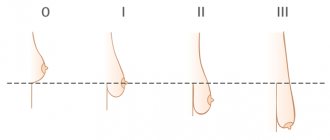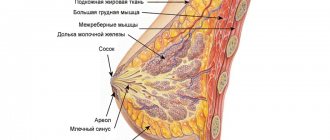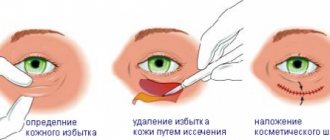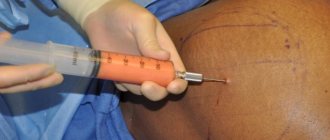Operation
Breast reduction surgery is performed under general anesthesia and is a serious surgical procedure that requires special attention.
During the preparatory stage, a plan for the operation is outlined, the locations of future incisions are determined, in order to make them invisible after healing.
Usually the operation is performed through two types of access:
- vertical (for minor correction volumes) The incision is located along the edge of the areola and goes down to the inframammary fold.
- "anchor" The incision is located along the edge of the areola, going down to the inframammary fold, where another incision is located. This type of access is used when it is necessary to remove a large volume of tissue (for example, with gigantomastia).
After removing excess tissue, cosmetic sutures are applied (a drainage tube is inserted into the chest), and a tight bandage is applied to protect and support the breast during the postoperative period.
Breast reduction surgery may involve both purely removal of excess tissue and a lift.
Mammoplasty. Breast reduction (reduction) in Minsk
The first breast augmentation surgery was performed in Belarus in 1993. 20 years later, mammoplasty is one of the most common procedures in domestic aesthetic surgery. Many women are not happy with their natural characteristics. Some people consider their breasts either too small or, on the contrary, too lush. Many people complain about asymmetry and sagging. And although the demand for mammoplasty around the world increases annually by about 6%, like any other surgical intervention, breast surgery has its contraindications.
Plastic surgeon, endoscopist surgeon in Minsk Sergey Stepanovich Stebunov: Contraindications for breast augmentation, as for many operations, are a general severe disease of the internal organs, a systemic disease (bone disease, connective tissue, etc.), bleeding disorders, mental illness, often diabetes mellitus. Before any operation, it is necessary to undergo a special list of examinations, take a blood test, urine test, biochemical analysis, blood clotting test, do an electrocardiogram, and fluorography. Women are required to see a gynecologist. If there is mastopathy, we recommend examination by a mammologist.
If the result of a breast lift or reduction mammoplasty (i.e. surgery to reduce the mammary glands) depends solely on the professionalism of the surgeon, then bust enlargement is impossible without the use of implants. Their shape and content vary. There are implants in the form of a drop and a hemisphere, with gel as a filler and saline solution.
Plastic surgeon, endoscopist surgeon in Minsk Sergey Stepanovich Stebunov: The choice of the shape of the implant depends on the situation, the shape of the mammary glands, their ptosis (so-called ptosis). Sometimes my patients and I immediately focus on round dentures, although most often women prefer the anatomical shape of implants. The skin undergoes a lot of stretching, especially in young women, so breast size can be noticeably increased.
Many women are afraid of breast augmentation surgery because they believe that it can cause cancer or interfere with breastfeeding in the future. Another common belief is that the implant can rupture, leak, or become unusable. And you will have to go under the surgeon’s knife again.
Plastic surgeon, endoscopist surgeon in Minsk Sergei Stepanovich Stebunov: Many years ago in America there were precedents, after which silicone prostheses were banned. Several decades of observation and development of plastic surgery virtually eliminate all these concerns.
During breast augmentation and lifting, an incision for an implant can be made in several places: in the inframammary fold, in the armpit, at the border of the areola and the skin.
Plastic surgeon, endoscopist surgeon in Minsk Sergey Stepanovich Stebunov: As a rule, an incision along the lower edge of the mammary gland is more convenient for the surgeon. The most inconspicuous approach is through the areola or through the armpit. If the patient’s anatomy allows, then we try to place the prostheses deeper, under the muscles. But this is not always possible and is not always an aesthetically more advantageous option.
Breast augmentation surgery is performed under general anesthesia and lasts from one hour to one and a half hours. And recovery takes several months.
Plastic surgeon, endoscopist surgeon in Minsk Sergey Stepanovich Stebunov: For a month after the operation, it is advisable to wear special compression garments and sleep on your back. As a rule, after two months the patient returns to her normal lifestyle. We evaluate the final result of the operation up to a maximum of six months. We generally do not recommend pregnancy or breastfeeding for at least six months after surgery.
An exciting neckline is beautiful and feminine. But is it worth going under the surgeon’s knife for him? It’s up to you to decide.
Postoperative period
The first days after reduction mammoplasty, it is necessary to change the dressings at the intervention site daily. As a rule, it is recommended to remain in bed for several days, but this recommendation depends on the degree of complexity of the intervention and the general condition of the patient. Specialists prepare an individual list of recommendations on physical limitations for each patient.
The bandage and drainage are removed after two days, after which it is mandatory to wear compression garments for at least 2.5-3 weeks. A bra with compression properties gives the renewed breast the desired shape and helps damaged tissue heal.
You can return to work (if it does not involve physical labor) a week after the operation.
Serious physical activity is excluded for at least 2 weeks (this also applies to raising your arms above chest level), and sometimes longer. Sports training and contact sports are excluded for at least six months.
Different types of tissue (and breasts are made up of glandular, muscle and fatty tissue) heal at different rates, which is why the breasts may appear asymmetrical for the first one and a half to two weeks. As recovery progresses, this asymmetry disappears.
Breast reduction surgery
During surgery
There are various special technologies used to reduce breast size . Typically, during surgery, the surgeon will make an incision around the areola (the pigmented area around the nipple) and at the bottom of the breast. Excess breast tissue, fat and skin are then removed to reduce the size of each breast.
In most cases, the nipple and areola remain attached to the breast. If you have very large and very saggy breasts, the nipple and areola must be removed and then re-sewn higher on the chest, as during skin grafting surgery.
After operation
Your chest will be covered with a gauze bandage or bandage. A tube will be placed under each arm in the armpit area to allow excess blood and fluid to drain. You will be prescribed pain medications, including antibiotics, to reduce the risk of infection.
During the first few days (week), the sensitivity of your breasts will be increased. It may also be swollen and bruised. The surgeon will also prescribe mandatory wearing of compression stockings.
You will need to reduce your physical activity for two to four weeks while the breasts heal. Your surgeon may recommend that you avoid wearing underwire bras for a month after surgery.
Usually, scars after breast reduction disappear after some time. You will need to make a follow-up visit to Belarus to remove the stitches and check how your breasts are healing.
Result
You can evaluate the result after one and a half to two months, but you will be able to fully enjoy your new breasts after 4-5 months.
For the operation it is necessary to undergo a number of tests:
- Complete blood count + platelets + coagulation (valid for 10 days)
- Blood type, Rh factor
- Coagulogram (valid for 10 days)
- General urine test (valid for 10 days)
- RW blood test (valid for 1 month)
- HIV test (valid for 1 month)
- Fluorography (valid for 12 months)
- Blood test for hepatitis B, C (valid for 1 month)
- Biochemical blood test (total protein, sodium, potassium, calcium, chlorine, cholesterol, urea, creatinine, glucose, total bilirubin, direct bilirubin, AST, ALT, chlorides) (valid for 10 days)
- ECG with interpretation (cardiologist's report if necessary) (valid for 1 month)
- Conclusions of specialized specialists (endocrinologist, cardiologist, therapist, etc. according to indications) (valid for 14 days)
- Physician's conclusion for persons over 50 years of age (valid for 14 days)
- Ultrasound of the mammary glands (valid for 1 month)
- In the presence of chronic diseases - an extract from the outpatient card with a physician’s conclusion (valid for 14 days)
Read reviews from our patients >>
HOW IS BREAST ENLARGEMENT SURGERY PERFORMED?
The operation is performed under general anesthesia and can last from 30 minutes to 2 hours. The surgeon makes marks on the body with a special marker. After administering anesthesia to the patient, the doctor makes incisions along the preoperative marking lines.
Where might the cuts be?
- Along the fold under the breast (submammary). It is mainly used for installing large implants. The disadvantage of this method is the visible scar, especially with raised arms or in a lying position.
- Along the edge of the pigmented area of the areola of the nipple (transareolar). Virtually leaves no traces of surgical intervention. The disadvantage is that there are restrictions on the size of implants installed when the areola diameter is less than 2 centimeters.
- Through the armpit (transaxillary). An almost invisible postoperative scar in the armpit, which can be noticeable in dark-skinned women, as well as with arms raised up.
The method used by surgeon Kosinets makes it easier to endure the postoperative period, namely, in the first days after surgery, patients do not have stiffness and painful restrictions in movements, as is usually the case.
Implant placement - what are the options?
- Under the breast tissue (subglandular method). Unfortunately, this technique is ineffective in patients with an initial small breast size and insufficient volume of integumentary tissue, which causes a high risk of implant deformation and the formation of capsular contracture. At the same time, placing the implant above the pectoral muscle causes less discomfort to the patient, reduces the level of swelling in the postoperative period, and contractions of the pectoral muscles cannot in any way affect the shape of the implant.
- Under the fascia of the pectoralis major muscle (subfascial method). With the subfascial method, the implant is placed under the fascia of the pectoralis major muscle. Based on clinical experience, this method has a very narrow range of practical application and is possible only in a small percentage of patients with well-defined fascia.
- Under the pectoralis major muscle (subpectoral). Currently, this technique is given the greatest preference, since the placement of the implant under the muscle sharply reduces the risk of capsular contracture (formation of dense fibrous tissue in the form of a capsule around the implant), practically does not interfere with mammography and allows for good results. aesthetic result.
One day after the operation, the patient can leave the clinic. On the 4th day, the doctor performs a control examination of the breast. Sutures are removed 10 days after surgery.









